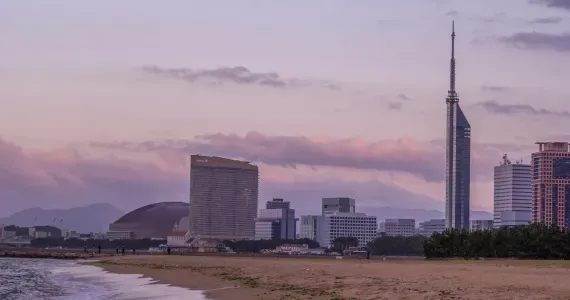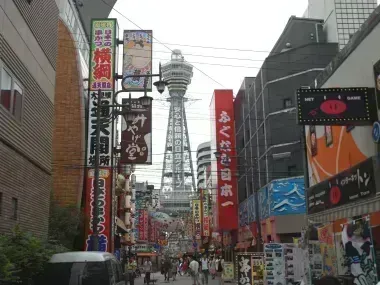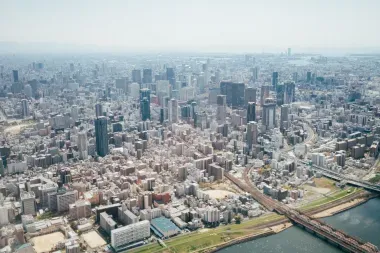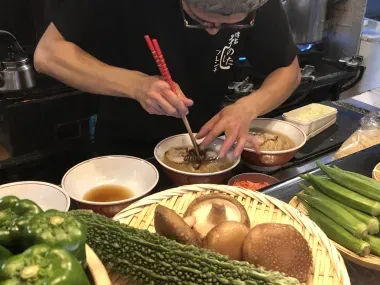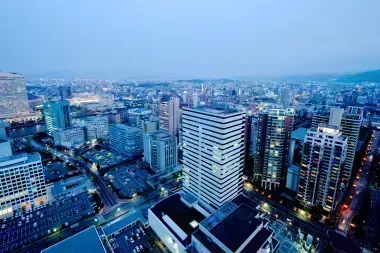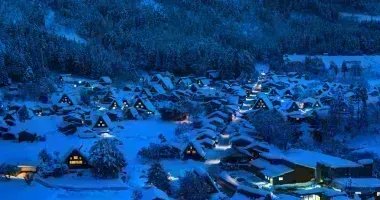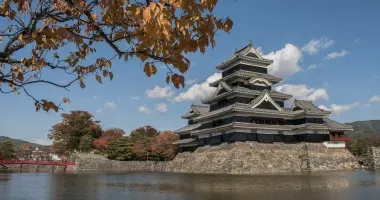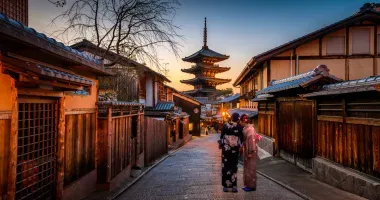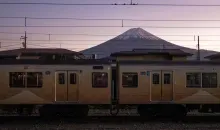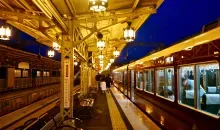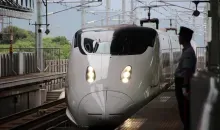How to get from Osaka to Fukuoka
Go from the largest city in Kansai to the largest city in Kyushu with the Shinkansen bullet train!
Getting from Osaka to Fukuoka with the Shinkansen bullet train
to 4 hours 30 mins
Hakata Station
Go from the largest city in Kansai to the largest city in Kyushu with the Shinkansen bullet train! Part of the latter half of the Tokaido-Sanyo Shinkansen Line, the journey moves south through Honshu Island, passing through the Chugoku Region and crossing the Seto Inland Sea into the island of Kyushu. The journey takes anywhere from 2 hours and 20 minutes to 4 hours and 30 minutes, depending on the Shinkansen train being ridden and traversing a total of 607 kilometers, or around 377 miles. From Osaka, travelers will actually depart from Shin-Osaka Station, the main Shinkansen bullet train hub in the city, then get off at Hakata Station, the largest station in Fukuoka. From Shin-Osaka Station, the first trains depart at 6:00 PM on the dot, with the last departure at 9:23 PM. Be aware of the last train departures, as train lines in Japan do not operate for a full 24 hours, and long-distance trains like the Shinkansen have earlier final departure times than other trains in Japan.
Tokaido-Sanyo Shinkansen bullet trains available on this itinerary:
| Nozomi Shinkansen Bullet Train | Mizuho Shinkansen Bullet Train | Hikari Shinkansen Bullet Train | Sakura Shinkansen Bullet Train |
*NOTE: All Shinkansen bullet trains on the Tokaido-Sanyo Line are accessible with the Japan Rail Pass; however, an additional fee is required to ride the Nozomi and Mizuho trains from Shin-Osaka to Hakata Station.
Reserve Shinkansen tickets from Osaka to Fukuoka!
Reserving seats on the Shinkansen
Individual ticket holders and holders of Japan Rail Passes can book seats in advance of boarding on Shinkansen bullet trains. Since many Shinkansen bullet trains contain non-reserved cars with seats that are available on a first-come, first-served basis, reservations are not always necessary for these trains. Usually, these are automobile numbers 1-4.
Though many people use the Shinkansen bullet train services during these times, there are some trains where all cars require a reservation. At the same time, we strongly advise all travelers to make every effort to purchase tickets with a reservation during peak travel periods in Japan, such as the spring and during the New Year's season. A reserved seat comes at an extra expense when buying a single ticket, although Japan Rail Pass holders are exempt from this fee.
Oversized Baggage on the Shinkansen
There are several guidelines that must be fulfilled in order for passengers with significant baggage to board the bullet train. As mandated by Japan Railway, luggage over 160 cm in total length, width, and height must be checked into the special large baggage area at the rear of the train car. Owners of such luggage are also required to book seats close to this area. Please take note that no luggage over 250 cm in total size is permitted on the Shinkansen bullet train.
Baby carriages, musical instruments in cases, and sports equipment (bikes, snowboards, etc.) also in cases are among the items that are exempt from these luggage regulations.
Exploring Osaka
The eccentric city of Osaka is located in the Kansai region and is actually the most populous city in that region and the third most populous city in all of Japan. For many, Osaka represents the definitive Japanese urban experience, characterized by retro-style streets and alleyways, food stalls, restaurants, bars, cafes, and even more! This is a great city to set out for the day and explore, and major locations that are both filled with local staples as well as hidden gems are the areas of Dotonbori and Shinsekai.
At Dotonbori, some of Osaka’s most iconic scenes can be witnessed. For example, the running Glico Man by the Ebisu Bridge has become a symbol of the city. But take the time to see what’s down a number of different streets and find bars and izakayas with lively patrons. Indulge in local street food favorites like okonomiyaki, takoyaki, and ramen. Then, take a ferry ride through the central Dotonbori Canal to see the surrounding area in a whole new way!
In Shinsekai, visitors can transport themselves back in time. The area has maintained its old-school feel since its inception in 1912, making the literal translation of its name, "new world,” a bit ironic. However, it’s the retro character of Shinsekai that makes it such a worthwhile visit. This is also a great spot to freely explore and see what you stumble upon, but make sure you don’t miss the view of Osaka Tower perfectly framed within the architecture of Shinsekai, another iconic view of the city.
But amongst the urban hustle and bustle of metropolitan Osaka, there is also a rich history tied to the DNA of Japan. The ancient Mozu Tombs are notable for their distinctive, key-shaped design and lush greenery that stands out among the surrounding urban scenery. Also, the Tower of the Sun sculpture designed by Taro Okamoto for the World Expo in 1970 stands as an icon of the city’s past. Be sure to visit and relax in the commemorative park it resides in as well as the art museum nearby! And for those looking for a bit of a trek out for a day trip, the nearby Himeji Castle is sure to impress! The castle itself is located actually in Hyogo Prefecture, about 1 hour and 20 minutes from Osaka’s center via train out to Himeji Station then one additional bus. First erected in 1333 then instated as one of the first UNESCO Heritage Sites in Japan in 1993, this is an essential destination for those out spending time in Osaka.
From Osaka, Shinkansen bullet trains departing from Shin-Osaka Station will head down south, stopping at a number of stations throughout the Chugoku region before arriving at Hakata Station in Fukuoka. This is also a major city in Japan, meaning those traveling between the two will get a taste of urban life in Japan as well as the distinct character of two of Japan’s most culturally rich regions.
Exploring Fukuoka
The capital city of Fukuoka Prefecture goes by the same name and is largely served by Hakata Station at its center. This is a city well-beloved by its residents for its numerous facilities for ease of life, such as its well-organized city layout, which is ideal for walking around and taking public transportation. In fact, the main hub of Hakata Station is just a short train ride away from the city’s main airport. There are also a number of parks and green areas within the city, enjoyed both by tourists and locals. As you walk around, take in the charming shops, cafes, and restaurants, as well as the historic monuments laced in between urban cityscapes. And of course, like many great destinations in Japan, Fukuoka is famous for its food culture, boasting great regional specialties and mastering dishes that travelers from abroad will often go out of their way for in order to try!
Since Hakata Station is where a vast majority of visitors to the city will be arriving, it’s definitely worth the time to highlight nearby attractions that can be checked out immediately and with ease! The next-door Canal City Mall is great for some shopping and picking up souvenirs, but near these two modern symbols of the city, Hakata’s rich past involving Japan’s spiritual history can be seen! There are a number of great Buddhist temples and Shinto shrines to visit, such as Kushida Shrine, known for its luxuriously decorated float, and Tocho-ji Temple, notable for its five-story-tall pagoda. See a more comprehensive history at the Hakata Folklore Museum, just a short walk away from the station. Deviate a bit from the building-dense inner city and visit Ohori Garden, complete with a tranquil, still pond at its center and a landscape garden. It’s also home to a number of waterfalls that decorate the garden. This is said to be the representative park of Fukuoka, frequented by locals to relax and take in the scenery.
Of course, the name “Hakata” will be well-recognized by fans of Japanese food, especially ramen. Hakata Tonkotsu Ramen is one of three representative ramens of Japan, the other two being Kitakata Ramen and Sapporo Miso Ramen. Hakata Tonkotsu Ramen is characterized by a rich pork-bone broth and thin noodles (try to order yours al-dente for some great textural variance!). There are a number of ramen shops and stalls nearby the station and around the city. There are also a number of stalls peddling other great local delicacies, such as yakiton (grilled pork skewers), and motsunabe (offal hot pot). This is a city proud and ready to share its food culture with the masses!
Arriving at Hakata Station from Shin-Osaka Station via the Sanyo Shinkansen, visitors will have a lot to check out in Fukuoka. Simultaneously, this station serves as a gateway to the rest of Fukuoka Prefecture and the entirety of Kyushu as a whole. Get ready to set out and explore Japan’s most southern island and its largest city, thanks to the Shinkansen bullet train!
From the Kansai metropolis to the gateway of Kyushu
Arriving at Hakata Station from Shin-Osaka Station via the Sanyo Shinkansen, visitors will have a lot to check out in Fukuoka. Simultaneously, this station serves as a gateway to the rest of Fukuoka Prefecture and the entirety of Kyushu as a whole. Get ready to set out and explore Japan’s most southern island and its largest city, thanks to the Shinkansen bullet train!

